Now Boarding
The other Japan: Discover Okinawa’s island charm
Sign up now: Get ST's newsletters delivered to your inbox
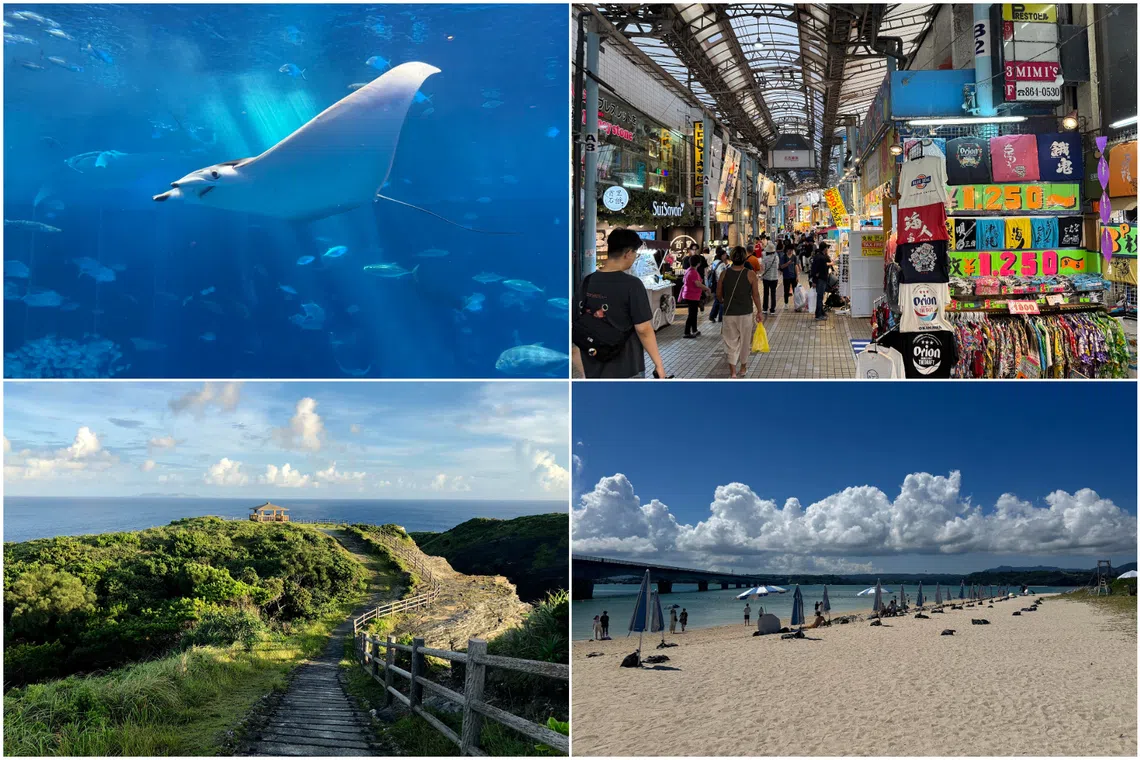
Okinawa was named one of Expedia's destinations of the year for 2026.
PHOTOS: EXPEDIA GROUP, SARAH STANLEY
Follow topic:
OKINAWA – When Japan’s famed Golden Route, spanning major cities Tokyo, Osaka and Kyoto, has been done and dusted, the sunny shores of its southernmost prefecture await.
Comprising more than 160 islands, subtropical Okinawa offers a blend of island life and urban Japanese living.
Like major cities, its capital Naha is lined with high-rise buildings and familiar retail brands: megastore Don Don Donki, convenience chains like Lawson and Family Mart, and local favourite Calbee Plus, known for its addictive potato snacks.
But Okinawa’s appeal also lies in its unpolished charm, where nature intertwines with its complex past. Once known as the Ryukyu Kingdom, Okinawa was annexed by Japan in 1879. It was devastated during World War II, and occupied by the United States until 1972.
The archipelago is what one of my Japanese Uber drivers calls “the other Japan”, as we chat via Google Translate while cruising past lush hills and beaches. He says the main Okinawa Island is “not very big”, but rich in culture and sights, and is surprised to hear I have travelled all the way from Singapore.
Many tourists who arrived at the same time – in early October – come from China and South Korea, as the countries celebrated their respective national holidays of Golden Week and Chuseok, or Korean Thanksgiving.
Okinawa Island spans about 1,200 sq km – roughly 1.6 times the size of Singapore – with a population of just over 1.4 million.
A direct flight from Singapore to Okinawa takes slightly over five hours. But since Jetstar Asia – the only airline to previously ply the non-stop route from Changi Airport – ceased operations on July 31, getting there now requires a transit in cities like Tokyo or Seoul.
Come Dec 15, low-cost carrier Scoot will launch three non-stop flights a week to Okinawa, with one-way fares starting at $190.
The island chain is gaining significant attention. According to travel booking platform Expedia’s Unpack ’26 report released on Oct 15, travel searches for the destination have increased by 71 per cent from 2024 to 2025.
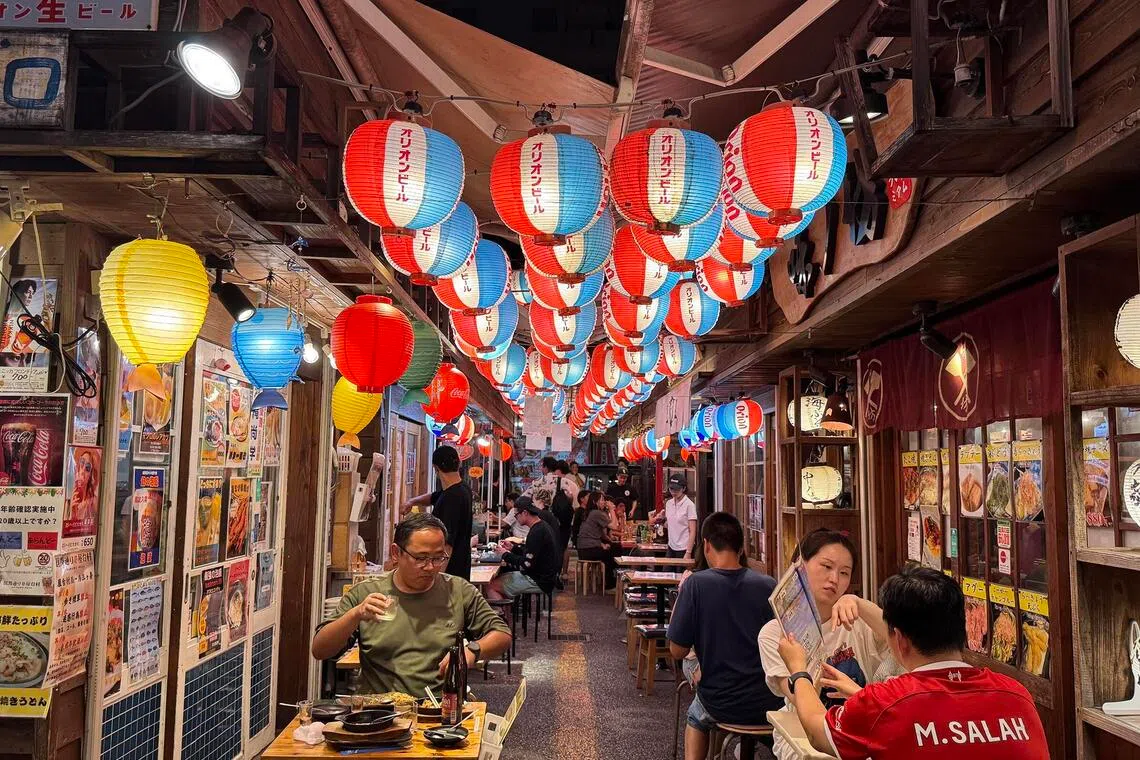
Tucked behind buildings along main street Kokusai-dori in Naha is a cluster of 20 eateries serving ramen, soba, sushi and more.
ST PHOTO: SARAH STANLEY
“Okinawa is like an alternative kind of Japan,” says Mr James Marshall, vice-president of global air account management at Expedia Group.
“I think people are getting more curious about different areas of travel and want to explore that by going into food or cultural events or sports or meeting locals.”
He adds that its location within the Asia-Pacific and growing flight accessibility have helped the destination gain visibility.
The report – based on data and insights from 24,000 travellers in 18 countries including Singapore, Japan and Australia – names Okinawa as one of Expedia’s top 10 destinations of the year for 2026, alongside Sardinia in Italy and Hobart in Australia.
The list incorporates Expedia’s new Smart Travel Health Check framework developed in 2025, which recognises destinations offering meaningful travel experiences and managing tourism sustainably.
Despite my driver’s claim that the island is “not very big”, I barely scratch its surface during my four days there, where I split my stay between buzzing Naha city in the south and the laidback resort town of Onna up north. Here are some highlights.
Thriving city life
In Naha, tourists throng the popular Kokusai-dori, or International Street, a nod to the American servicemen who frequented the area after being stationed here post-WWII.
I stay a two-minute walk away at JR Kyushu Hotel Blossom Naha, in a deluxe king room which typically costs less than $200 a night.
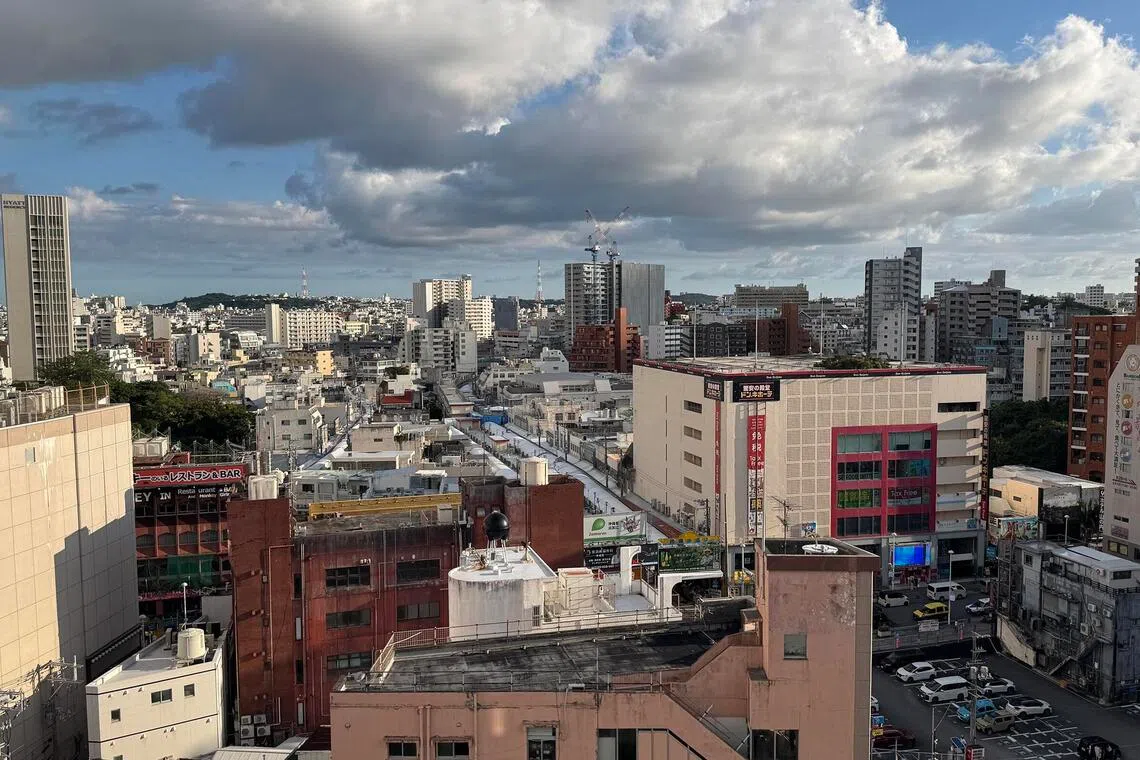
The city of Naha is bustling with activity and tourists who spend hours in the popular Kokusai-dori Street.
ST PHOTO: SARAH STANLEY
The street teems with shops, bars and restaurants selling crafts, clothes and food. A five-storey Don Don Donki megastore is open daily from 9am to 5am.
Branching off from the main street is Heiwa-dori, a sheltered arcade selling trinkets and snacks. In the October heat, with daytime temperatures at a high of 31 deg C, walking through it is both a respite and an adventure.
I pass stores selling habushu. This is Okinawan liqueur aged with a whole venomous pit viper inside that is said to be safe to drink after ageing, though I do not put this to the test. There are also many shisa figurines, lion-dog guardians believed to ward off evil and bring good fortune.
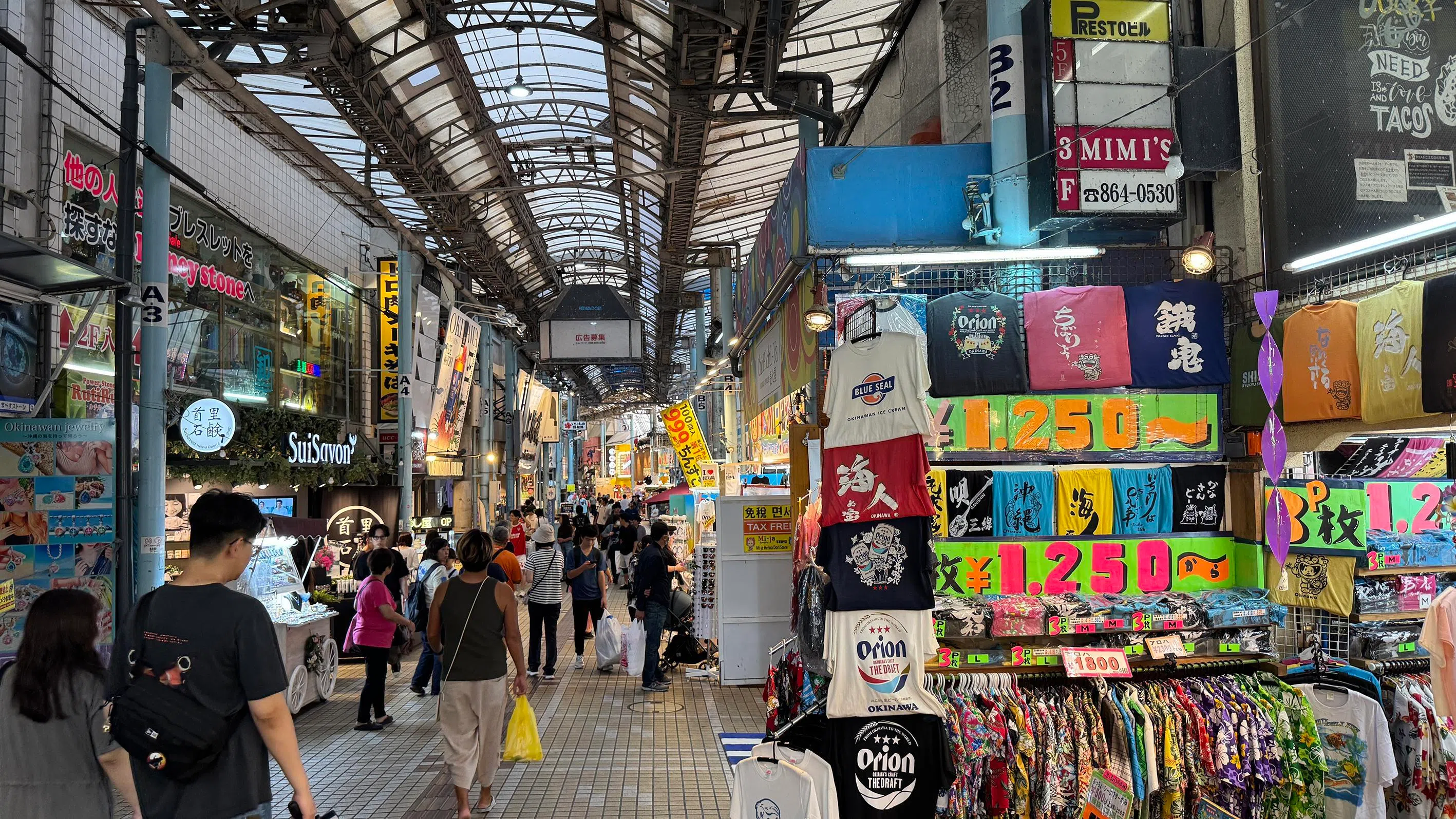
Heiwa-dori, a sheltered arcade off the main Kokusai-dori Street in Naha, has small shops selling trinkets and snacks.
ST PHOTO: SARAH STANLEY
Lost in the maze of lanes, I stumble upon cute cafes in back alleys selling musubi – a Japanese rice-ball snack typically filled with grilled luncheon meat – and traditional pottery stores behind nondescript doors.
Kokusai-dori hums day and night. Karaoke joints and izakaya spots stay open past midnight, while the Kokusai Street Food Village of 20 stalls comes alive as evening falls.
Taste of the sea
For seafood lovers, visiting Makishi Public Market off Kokusai-dori is a must. The compact two-storey space sells fresh catch downstairs and serves it upstairs, cooked to order or as sashimi.
Every store in the market offers a good selection of seafood, so visitors here are on the prowl for freshness and good value.

Most stalls display fresh catch on ice, with the bright blue parrotfish among the most eye-catching.
ST PHOTO: SARAH STANLEY
When I visit, giant green turban snails – the size of my head and weighing about 2kg each – sell for 4,200 yen (S$36). One vendor suggests, in Mandarin, eating half as sashimi and the rest grilled with garlic and butter.
Alaskan king crabs that weigh around 2kg fetch roughly 30,000 yen and can easily feed four people, while the bright blue parrotfish – a local delicacy – catches my eye. Curious, I try parrotfish sushi and find its meat creamy and sweet.
Another Okinawan speciality is sea grapes, strands of seaweed covered in tiny green bubbles that burst with briny flavour. Like much of the local produce, sea grapes tout numerous nutritional benefits such as high mineral and vitamin density.
Okinawa’s diet, rich in vegetables like bittergourd and sweet potato, and soya-based foods such as tofu and miso, contributes to its Blue Zone status – regions where people are said to live significantly longer and healthier lives.
According to studies published on the US’ National Institutes of Health online library, 40 to 50 in 100,000 Okinawans live to be centenarians. Other academic research of the traditional Okinawan diet suggests it is associated with lower risks of cancer and chronic diseases such as heart disease.
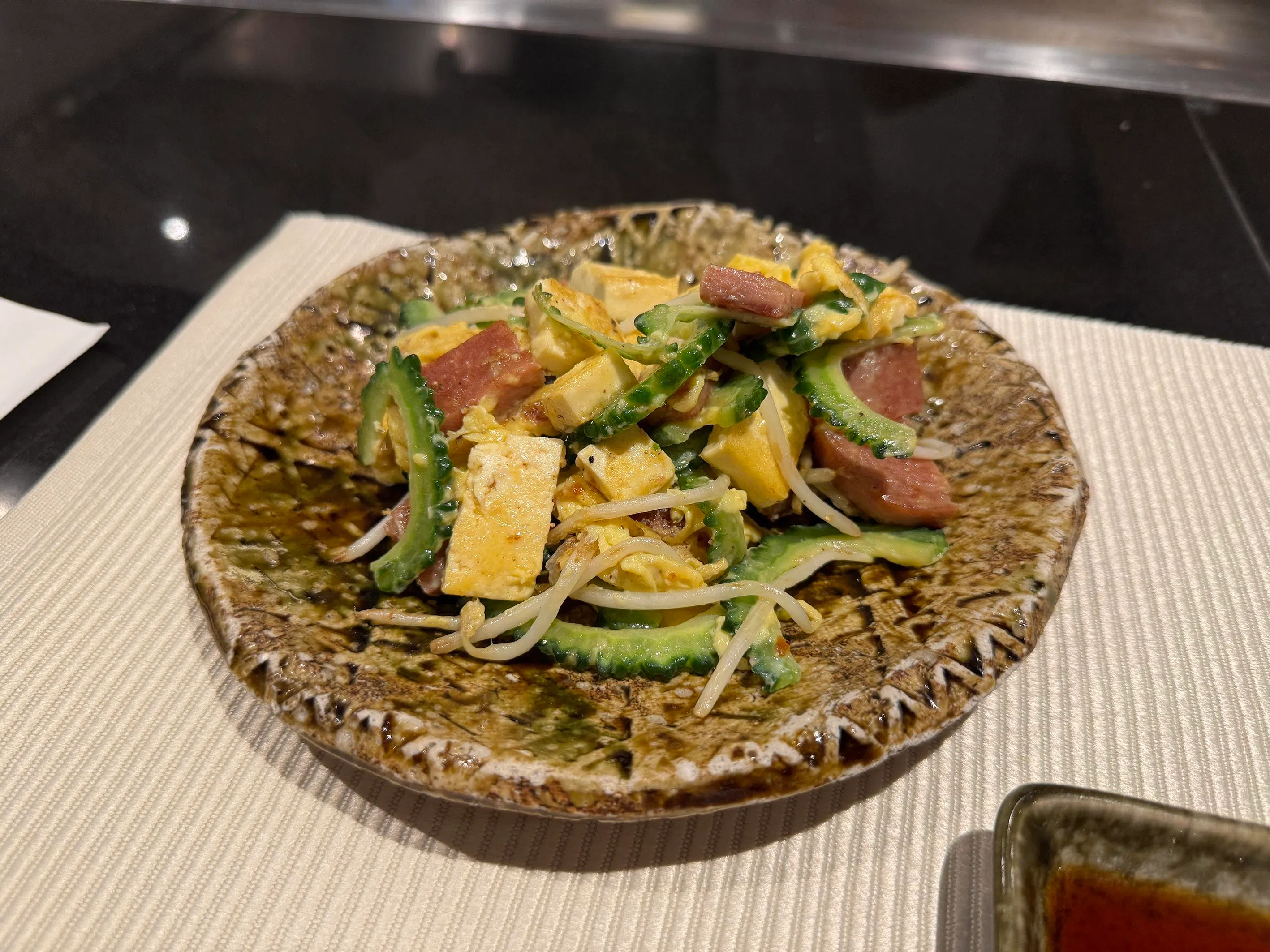
Bittergourd is a common ingredient in Okinawan cuisine and features in goya champuru, a local stir-fry dish.
ST PHOTO: SARAH STANLEY
I keep that in mind as I eat goya champuru – a vegetable stir-fry made with bittergourd, bean sprouts and eggs – during dinner. The gourd is an acquired taste and its bitterness lingers long after it is swallowed.
Nature’s charm
The resort town of Onna, about an hour’s drive from Naha, lies along a scenic coastal road passing the towns of Chatan, Uruma and Yomitan – each with its distinct character.
Chatan, home to the US’ Kadena Air Base, has Japanese and Western influences. Its Mihama American Village entertainment complex – popular with tourists – brims with burger joints, taco bars, Japanese restaurants and American retail brands such as Hurley and Crocs.
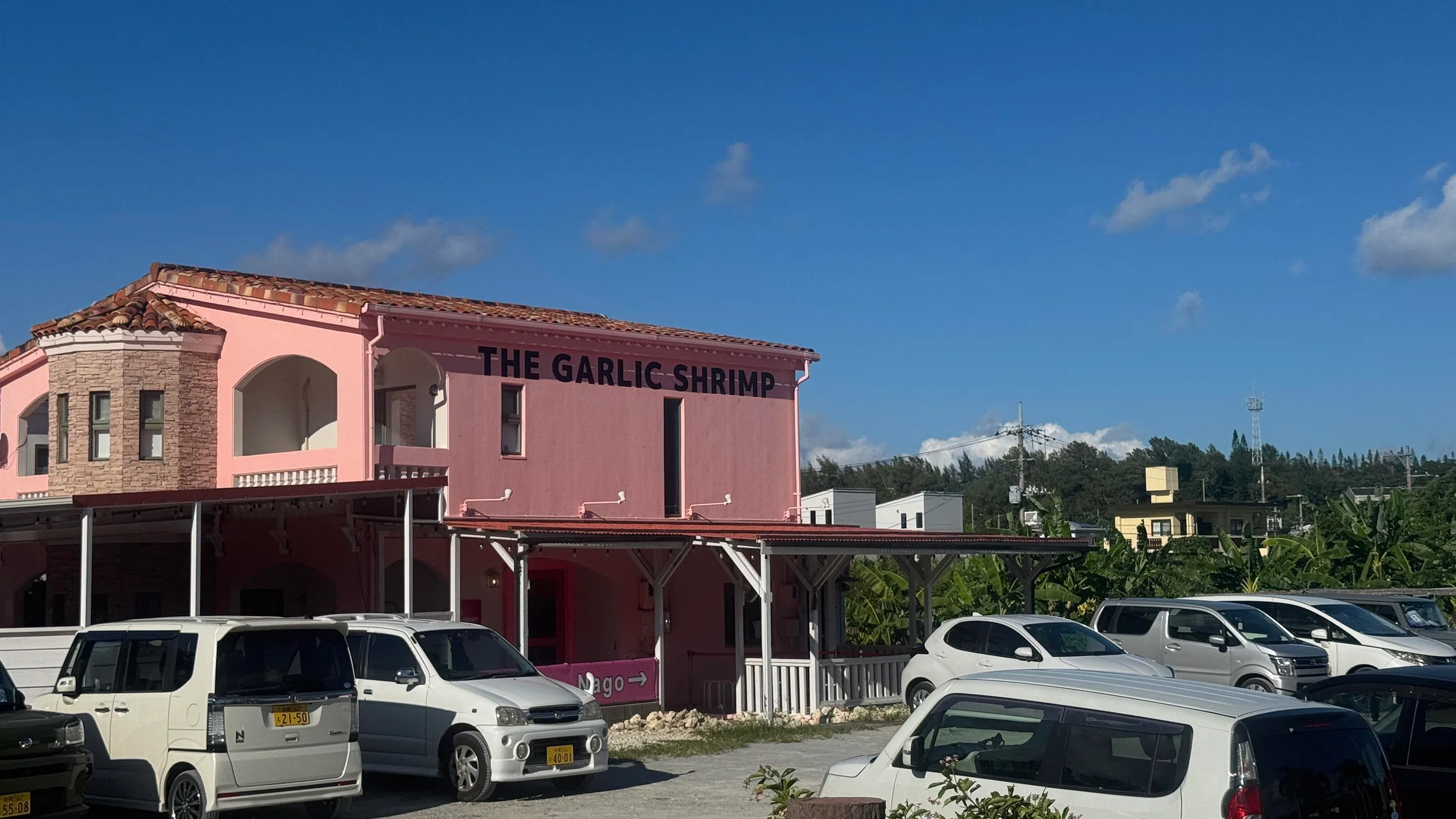
Head to The Garlic Shrimp in Onna, which sells plump shrimp coated in a rich garlic butter sauce served with rice.
ST PHOTO: SARAH STANLEY
In Onna, known for its calm vibe and scenic views, I stay at The Atta Terrace Club Towers. The property is perched on elevated land with views of greenery and sea, and a night in its Club Deluxe room with a king-size bed typically costs around $500.
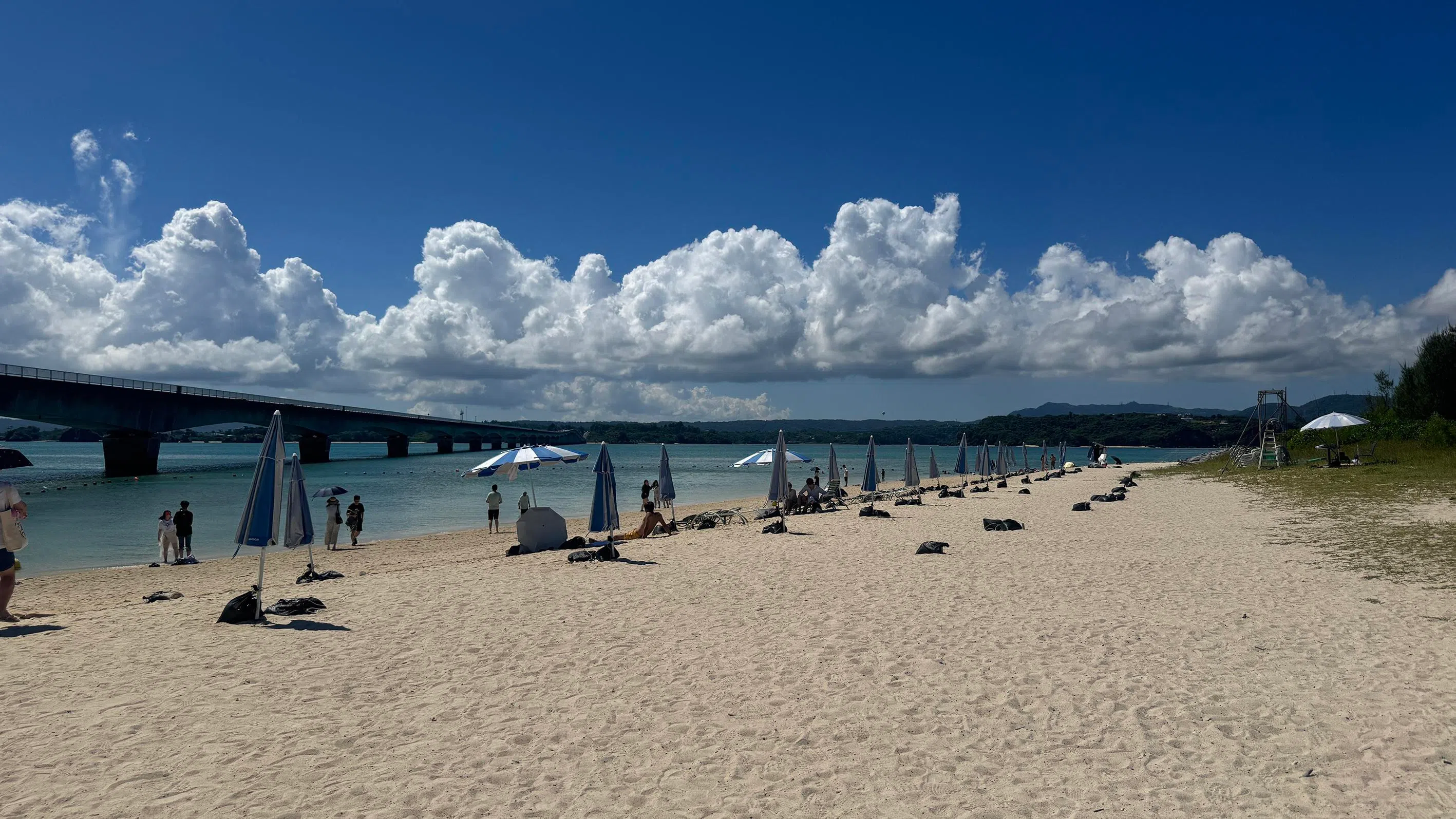
Kouri Beach, near Kouri Bridge on the south of the island, is a popular spot for beachgoers.
ST PHOTO: SARAH STANLEY
The archipelago teems with marine life – from coral reefs to migrating whales – and its clear waters are perfect for underwater adventures.
Southern islands like Kerama, Ishigaki and Iriomote are renowned for these activities. In the northern region, the Blue Cave – an ethereal limestone cave full of marine life – is a worthwhile stop.
I also visit the four-storey Okinawa Churaumi Aquarium, home to over 700 species of marine life. General admission costs 2,180 yen an adult, while children under six enter free.
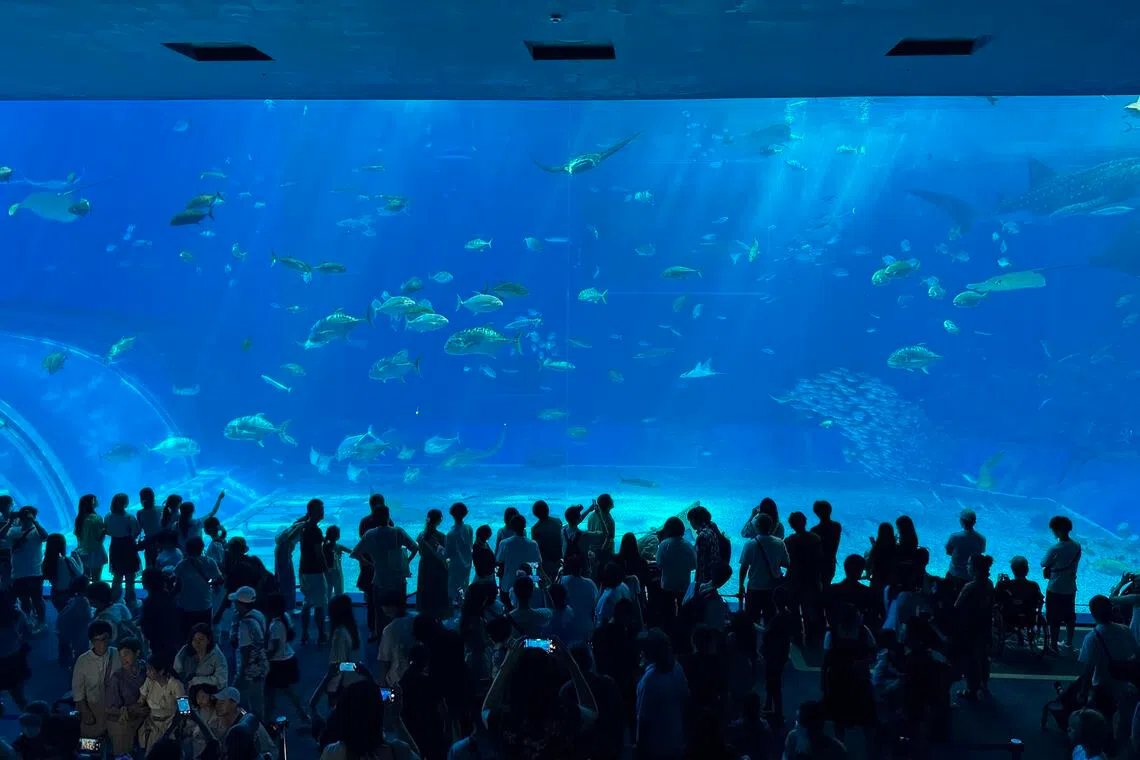
At Okinawa Churaumi Aquarium, there are over 700 species of marine life.
ST PHOTO: SARAH STANLEY
Its massive Kuroshio Sea tank – measuring 10m deep, 35m wide and 27m long – houses manta rays, tropical fish and its star resident Jinta, an 8.8m-long male whale shark raised in captivity since 1995.
Whale shark research is among the projects the aquarium has undertaken, in the hope of better understanding the creatures’ life cycle and possible conservation efforts.
While surreal to see these marine creatures in close proximity, there is something disconcerting about watching them swim repeatedly in circles. I prefer the deep-sea enclosures, where bulgy-eyed, sharp-toothed fish blend with rocks, and bioluminescent marine life twinkle under ultraviolet light.
Among the aquarium’s most ground-breaking innovations is co-developing an artificial uterus apparatus for sharks. This replicates the environment of a shark womb, and was used in the successful rearing and delivery of a Moller’s lanternshark in 2021 – a world’s first – paving the way for developing conservation methods for rare shark species with declining populations.
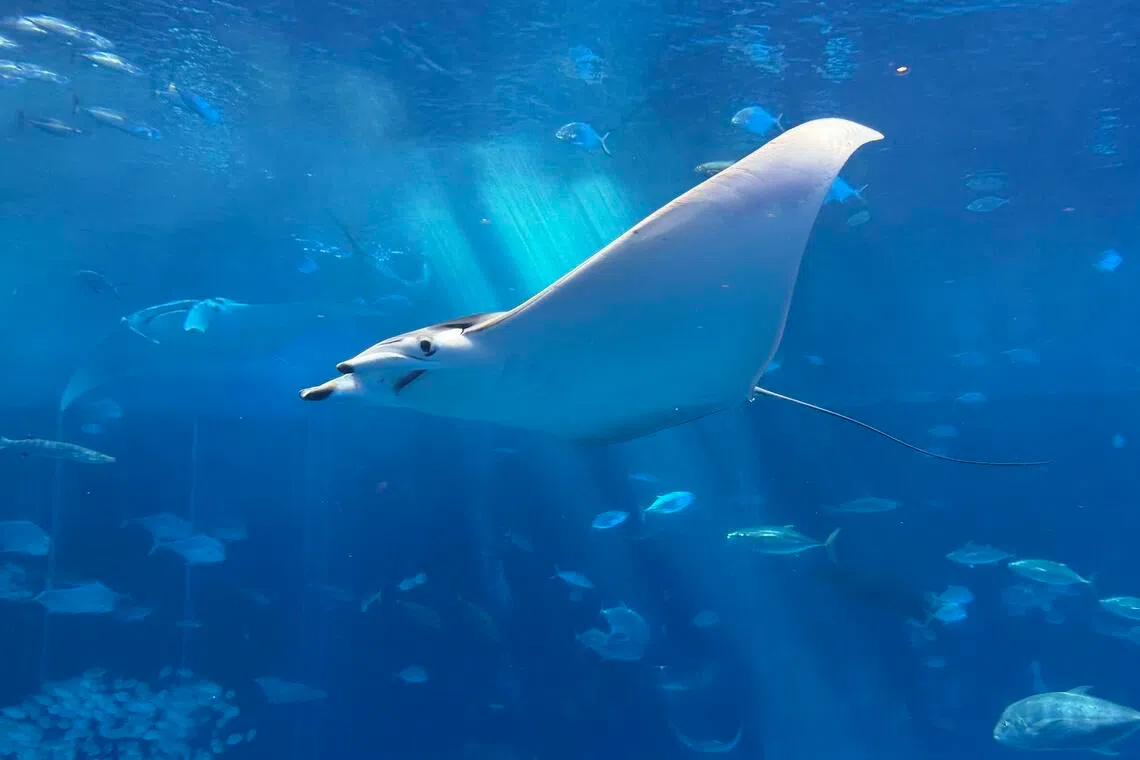
Giant manta rays are among the marine life in the aquarium’s Kuroshio Sea tank, which is one of the largest in the world.
ST PHOTO: SARAH STANLEY
Amid swarming crowds of excitable families, I make a beeline for the exit and buy myself a pineapple soft-serve cone for 600 yen from Blue Seal ice cream parlour – a speciality dessert brand popular for local flavours like Okinawan Salt Cookies and Beni-imo (sweet potato).
For first-time visitors, Okinawa’s headline attractions – from Shuri Castle to the bustle of Kokusai-dori – are essential boxes to tick. But beyond these tourist favourites lies a quieter, more intimate side of the island that asks to be felt rather than seen.
Almost all my favourite experiences on the island centre on enjoying the beach and taking slow walks in quieter neighbourhoods. If you can, give the island at least a week to show you why it is worth the journey.
Travel tips
Renting a car is the most flexible way to explore Okinawa, with hatchbacks like a Honda Fit costing around $85 a day. Vehicles can be booked on Expedia and picked up at Naha Airport.
Attractions – such as tickets to Okinawa Churaumi Aquarium, snorkelling tours in Blue Cave and mangrove kayaking tours – can also be booked on Expedia.
For non-drivers, the Yui Rail monorail offers easy access within the southern region, from Naha Airport to attractions like Shuri Castle, a Unesco World Heritage Site. The castle, destroyed by a fire in 2019, is being rebuilt and is set for completion in 2026. Other nearby stops include Naminoue Beach and the ornate Chinese-style garden Fukushu-en.
While diving and snorkelling are possible year-round, the best conditions are between May and October, with warmer waters and better visibility. Take along a waterproof phone case to capture photos or videos. It is sold on e-commerce sites like Shopee and Lazada, or locally at Don Don Donki for about 1,000 yen.
The writer was hosted by Expedia Group.
Now Boarding is a series on destinations that are taking off. For more travel stories, go to
str.sg/travel
This article contains affiliate links. If you buy through these links, we may earn a small commission.


